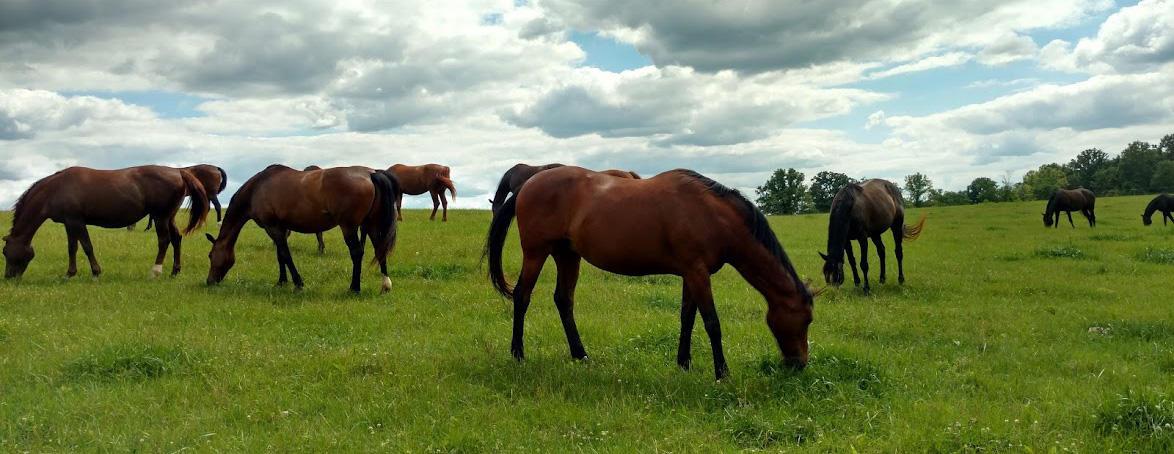Key points:
- Laboratory testing is the only way to know if hay is low in sugars, also known as nonstructural carbohydrates or NSC.
- Testing sugars in fresh pasture forage is less reliable than testing hay due to day-to-day and time of day fluctuations.
- For horses requiring a low-sugar diet, choose forages with less than 10% nonstructural carbohydrates, or as directed by your veterinarian”.
- While weather, forage species, cutting, and time of year give some insight into the sugar concentration and guidelines for managing pastures, the most reliable way to determine suitability for of at-risk horses is forage testing.
- Warm-season grasses, like teff, generally contain less soluble sugar than cool-season grasses.
- Pasturing horses in the morning instead of the afternoon, limiting grazing during cool weather in the spring and fall and restricting intake through muzzling can reduce the intake of soluble sugar.
High concentrations of nonstructural carbohydrates in forages can cause health problems for some horses and other domesticated equines like ponies, donkeys, and mules. Nonstructural carbohydrates can especially harm horses at risk for pasture-associated laminitis, colic, insulin dysregulation or equine metabolic syndrome. This publication summarizes the role of NSC in forage plants, describes the factors causing varying levels of NSC in forages and provides management options for limiting NSC intake in horses.
Carbohydrates in forage plants
From the perspective of the grass plant, sugars are the primary currency of growth. To produce new roots, leaves, stems and seeds, grasses and all other plants require energy from sugar and other related carbohydrate molecules. Following is a simplified description of how perennial grasses make and use sugars. Keep this process in mind when considering sugar concentration in forages.
The leaves of a plant take in carbon dioxide from the atmosphere, water from the soil and light from the sun to create the energy that keeps the plant alive and allows it to grow. This process is called photosynthesis. The primary energy molecule produced by photosynthesis is the simple sugar called glucose. Once glucose is created in the leaves, it is converted into sucrose and moved to the plant’s vascular system. There, the sucrose supplies energy for growth or is stored for later use. In the growing part of the plant, sucrose provides energy for all the physiological functions required to produce new plant tissue. This includes conversion into more complex carbohydrates like cellulose, pectin and lignin, which make up the cell walls and scaffolding of the plant, providing its structure.
Sometimes people use the term “low-carb” when referring to hay. This is misleading because structural carbohydrates are always present. These structural compounds like fiber and cellulose are required for healthy digestive function in horses. Stored sugars, including simple sugars (glucose, sucrose, and fructose), starch and fructan, do not make up the plant’s physical structure and are called nonstructural carbohydrates. NSC are of concern for horses with insulin resistance, pasture-associated laminitis or equine metabolic syndrome.
In most forage grasses, NSC are primarily stored in the lower stem base close to the ground, with only a small fraction stored in the roots. NSC allows the plant to survive periods of stress, such as mowing or grazing. For example, when a horse grazes and removes the leaves from a grass plant, the plant relies on stored NSC to initiate regrowth.
NSC also play a critical role in helping grasses survive stressful environmental conditions like hard freezes during winter or periods of intense drought in summer. Experienced hay growers and livestock managers know they need to be aware of their mowing and grazing practices. If they deplete the NSC stored within the plant stubble or stem base, those plants will likely not survive.
Grasses will never be “sugar-free” because NSC are always present. Still, the amounts differ. Many factors control the NSC concentration of a grass plant, and their interactions are complex. Because of this, accurately predicting the sugar concentration of hay or pasture is not possible. Here are some factors involved in NSC accumulation within forage grasses.
Identifying lower-sugar hay and pasture
Grass species and varieties
Researchers have studied the NSC concentration of various forage species in a range of climates and regions worldwide. While researchers measure differences in the NSC concentration of different grass species in side-by-side plots, complex interactions among weather, climate, stage of growth and management factors significantly impact the results. This makes grass species alone a poor indicator of NSC concentration. However, two genetic factors play a role in NSC concentration in grasses: the type of photosynthetic pathway and the selection of varieties bred for high NSC concentration.
A photosynthetic pathway is a method plants use to capture carbon dioxide during photosynthesis. Cool-season grasses (those that use the C3 photosynthetic pathway), including tall fescue, orchardgrass, ryegrasses, bluegrass, timothy and bromegrasses, tend to have higher NSC concentrations than warm-season grasses (those that use the C4 photosynthetic pathway). Warm-season species including bermudagrass, crabgrass, sorghum, switchgrass, millet and teff, generally have lower NSC concentration. None of these warm-season species is well adapted for pasture in the Pacific Northwest, but some are grown for hay. C4 species are commonly used in grazed pasture in the southeastern United States and elsewhere with hot or tropical climates. Teff has become a popular species for hay among horse owners across the country because of its fine leaves and lower NSC concentration. Note that warm-season grasses can still have NSC concentrations higher than recommended for horses with low-NSC requirements. Thus, grass species and varieties are not a sufficient guide to ensure low sugar concentration in hay and pasture.
Varieties of perennial ryegrass selected for increased NSC concentration have recently been released in the United States. These grasses, sometimes called high-sugar grasses, can be desirable in production livestock settings where weight gain or milk production is the objective. Avoid varieties marketed as “high-sugar” or “HSG” for horses needing low-NSC feeds.
Harvest, stage of growth, weather and climate
Harvest (first cutting, second cutting, etc.) and growth stage are unreliable indicators of sugar concentration. Although some general principles are worth noting, none of these will ensure that any one pasture or bale of hay is safe for a horse in need of low-NSC feed.
Cool-season grasses accumulate NSC under cool, sunny conditions in early spring and late fall. At these times, plants are photosynthesizing efficiently, but growth is limited by day length and low nighttime temperatures. Limiting grazing of lush pastures in early spring is often recommended for horses needing a low-NSC diet. When grasses transition to seedhead production, NSC levels should drop quickly as fibrous stems accumulate. However, this has not been found consistently in field experiments. Hot summer temperatures limit the accumulation of NSC. But at the same time, moderate summer drought can increase NSC concentrations.
Cloudy conditions before hay harvest and shade in pastures may reduce NSC concentration of forages by reducing photosynthesis. However, these factors cannot be expected to produce sufficiently low NSC levels for horses at risk of pasture-associated laminitis or with equine metabolic syndrome.
Climate can drive differences in NSC concentrations in forages. All other factors being equal, higher elevation areas generally produce higher NSC in forages than lower elevations, given their cooler temperatures. Irrigated forages grown in the Intermountain West accumulate high concentrations of NSC because of the clear, sunny conditions and cool nighttime temperatures compared to warmer conditions in the humid midwestern and eastern United States.
Irrigation and fertilization
Drought stress limits growth and causes an increase in NSC concentration of forages. Appropriate irrigation practices in moisture-limited environments increase growth rates and reduce NSC as excess energy is used to form biomass rather than accumulated as NSC. However, under exceptional moisture stress, when forage plants are near death, added irrigation water can increase NSC concentration.
Like drought stress, nutrient deficiency, particularly nitrogen, can limit the growth of grasses and cause NSC to accumulate. Adding nutrients to an underfertilized pasture or hayfield will often cause a reduction in NSC. But optimal fertilization, like optimal irrigation, is no guarantee of forage safe for horses requiring low-NSC feed.
Time of day
The time of day when hay is cut or animals are allowed to graze can significantly impact forage NSC. NSC concentration is generally lowest in the morning. This is because forage plants create new energy through photosynthesis during the day. That energy may be used for maintenance or growth, may be stored as NSC or used for other physiological processes. There is no light for photosynthesis at night, but the plants still use energy to grow and repair cells. The molecules that supply that energy at night are the NSC. By daybreak, plants have drawn down their pool of NSC. As photosynthesis begins again, the NSC is replenished throughout the day, peaking in the late afternoon/evening (Figure 1).
Studies comparing the NSC concentration of morning pasture to evening pasture typically measure a 2%–3% increase in NSC in the evening compared to the morning. Some studies have measured a 9% increase in NSC in the evening. Pasturing horses in the morning and feeding hay harvested earlier may result in a diet comparatively lower in NSC. Note that NSC concentration can be increased by cold (temperatures less than 40°F) or freezing temperatures, so the pattern of lower NSC in the morning may not hold true on chilly or frosty mornings.
Testing
Laboratory testing is the only way of accurately determining the NSC concentration of forages. Many agricultural laboratories will include carbohydrate analysis with standard forage quality testing packages, and some labs offer special sugar or carbohydrate-focused testing packages.
Two laboratory approaches are used for determining the NSC concentration of forages: wet chemistry and near-infrared spectroscopy, known as NIRS. Wet chemistry methods are a direct measure of forage quality. Wet chemistry uses solvents such as water, ethanol or acids to extract certain compounds from the forage sample. The solvents are analyzed to determine the concentration of sugar or other compounds present.
NIRS uses the reflection or transmission of certain wavelengths of light to indicate the chemical composition of a forage sample. This method gets its name from the near-infrared region of the electromagnetic spectrum. NIRS methods use predictive models based on a population of similar samples analyzed through wet chemistry. Both wet chemistry and NIRS methods can accurately test forages for NSC.
Use a reputable forage testing laboratory for feed and NSC analysis. Consider a lab certified by the National Forage Testing Association (NFTA). While NSC testing is not one of the forage quality parameters on which NFTA labs are certified, participation in the certification program indicates a lab’s high commitment to the accuracy and precision of forage testing. Here is a list of NFTA labs.
Sample carefully — a single forage analysis may be used to determine the sugar concentration and forage quality of a truckload of haybales. Several cups of hay will be submitted to the lab and the lab will only analyze a couple of teaspoons of that ground forage. Submitting a properly collected representative sample is critical to an accurate forage test result.
See Recommended Principles for Proper Hay Sampling, for instructions on collecting representative samples or watch this video.
While pasture herbage such as hay can be analyzed for NSC concentration, forage quality, including NSC in pastures, can change quickly. NSC concentration in pasture grasses will change from morning to evening and from day to day based on weather and management factors. Because of rapid changes in pasture quality, the time required to ship samples and receive results, and metabolic changes in forage quality, which occur in fresh-cut forage, NSC testing for pastures is less useful than testing more stable conserved feeds like hay.
What’s the safe level of NSC?
The safe level of NSC will depend on your horse, activity level and any associated veterinary diagnoses. As one rule of thumb, the American College of Veterinary Internal Medicine recommends NSC concentration, measured as the sum of water-soluble carbohydrates and starch, be less than 10% when fed to horses with equine metabolic syndrome. Consult your veterinarian or nutritionist to determine your horse’s dietary requirements.
Summary of management options
- Test hay before you purchase or have the seller provide a forage analysis report.
- Choose hay with an NSC percentage less than 10% for horses requiring a “low-sugar” diet, or follow your veterinarian’s recommendations.
- Look for warm-season grass hay because it generally contains lower concentrations of NSC than hay made from cool-season grass species.
- Soaking hay for 15 to 60 minutes can reduce NSC concentration, but soaking can also leach valuable minerals from the hay, and results vary.
- NSC concentration of pastures changes quickly, which can make testing fresh herbage unreliable. If animals must be on pasture, ensure they are not hungry when you turn them out, consider pasturing early in the day when NSC is lowest and use a grazing muzzle to limit intake.
- Ensure that hayfields and pastures have optimum soil fertility. Adequate nitrogen and other nutrients encourage growth and dilution of carbohydrates.
- Avoid grazing pastures to a low residual stubble height. Carbohydrates are stored in the stem bases of grasses, and closely grazed pastures can expose horses to excessive NSC.
Resources
Downing, T. and M. Gamroth. 2007. Nonstructural Carbohydrates in Cool-season Grasses, SR 1079-E. Oregon State University Extension Service .
Duggan, S. J. and T. Downing. 2022. A Horse Owner’s Guide to Pasture-associated Laminitis, EM 9354. Oregon State University Extension Service.
Frank, N., R. Geor, S. Bailey, A. Durham and P. Johnson. 2010. Equine Metabolic Syndrome. Journal of Veterinary Internal Medicine. 24:467-475.
Fransen, S., G. Pirelli, M. Chaney, L. Brewer and S. Robbins. 2017. The Western Oregon and Washington Pasture Calendar, PNW 699.
McIntosh, B., T. Cubitt and S. Kevan. 2018. Pasture-Related Diseases and Disorders. In: Horse Pasture Management. Ed: P. Sharp. Elsevier: London.
Villalba, J., S. Ates and J. MacAdam. 2021. Non-fiber Carbohydrates in Forages and Their Influences on Beef Production Systems. Frontiers in Sustainable Food Systems: 5.
Acknowledgements
The authors would like the thank Steve Fransen, Washington State University, and Joe Brummer, Colorado State University, for their thoughtful review and suggestions on an early draft of this document.







